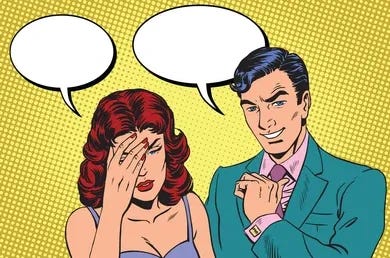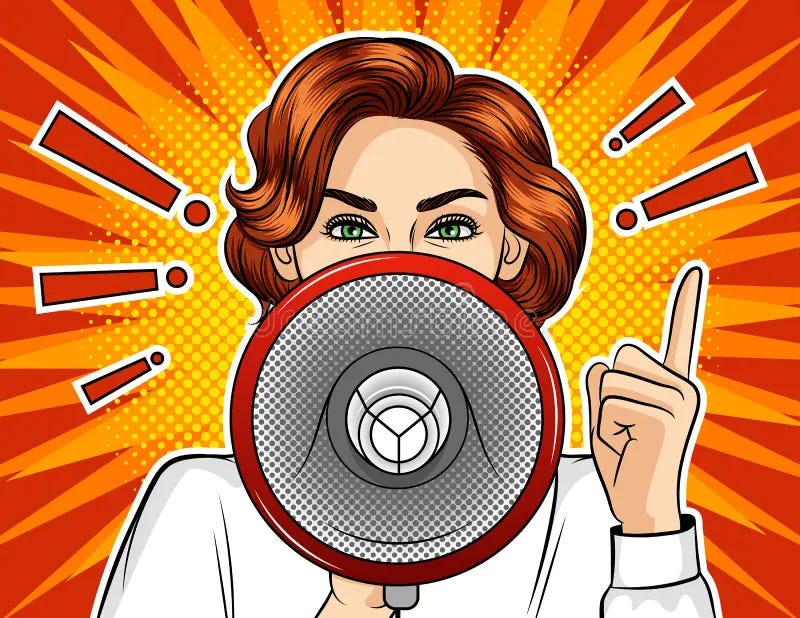The 5 Rules of Great Dialogue
How to Write Lines That Spark, Reveal, and Drive the Scene Forward
There’s a moment in writing when your characters stop sounding like words on a page and start feeling like real people.
You know it when you hear it. The rhythm is right. The tension hums. The line lands hard, or soft, or cuts deep without raising its voice. Suddenly, the scene moves.
That’s the power of great dialogue.
And it’s not just about sounding “natural.” Great dialogue does work. It carries emotion, reveals character, builds conflict, and pushes the story forward, all without breaking a sweat.
Below are the five core rules I teach again and again in workshops at universities, workshops, conferences, writers groups and share with my clients.
These aren’t tricks. They’re principles. Simple, yes, but when you follow them, your scenes crackle. Dialog is such an important part of fiction writing as it holds so much weight and can divulge so much, even with what is not said.
Why Dialogue Matters (More Than You Think)
Good dialogue is invisible. It hums quietly beneath the surface, never drawing attention to itself. But great dialogue? Great dialogue crackles. It sizzles like a live wire between characters, full of tension, wit, subtext, and rhythm you can feel in your bones.
Great dialogue reveals more than facts, it reveals character. Who they are when they think no one’s watching. It drips with personality, shaped by upbringing, desire, fear, power. A single word choice can be a confession. A pause, an accusation.
It’s not just what your characters say. It’s what they withhold. What slips between the lines. Great dialogue is a game of cards, everyone bluffing, everyone bleeding truth.
When it’s working, you don’t even notice the craft. But the scene tightens. The stakes rise. You’re pulled forward, breathless.
Because when it’s done right, dialogue doesn’t just support the scene, it is the scene. Plot doesn’t just happen between the lines. It happens inside them.
Rule #1: People Rarely Say What They Mean
Let’s be honest.
When was the last time you told someone exactly what you were feeling?
No filters. No phrasing. No softening, sidestepping, or dressing it up in sarcasm or politeness.
Now think about the last time you:
Lied (even a little),
Dodged a question,
Tried to impress someone without making it obvious,
Downplayed how hurt you were,
Said something nice that secretly meant something else.
That’s how real people talk.
And that’s how your characters should talk, too just with higher emotional stakes.
Bad Dialogue:
“I’m really mad at you.”
It’s to the point and clear, but it’s also flat, surface-level, and lifeless. It tells us something without making us feel it. There’s no complexity. No tension. No nuance.
Better Dialogue:
“Oh, you remembered my birthday this year. That’s new.”
Now we’re getting somewhere. This line has edge. Bite. It sounds polite, but it hurts. There’s disappointment, resentment, maybe even a flicker of hope beneath the sarcasm. It doesn’t say “I’m mad,” but it screams it all the same.
That’s the magic of subtext. Say Less. Mean More.
Subtext is what lives beneath the words: What the character is really feeling, needing, fearing, but doesn’t say outright. It’s the tension under the surface. The emotional heat that makes a line feel dangerous, or funny, or devastating.
Readers are smart. They don’t need everything spelled out. In fact, they want to participate. They want to read between the lines, to catch what isn’t being said. That’s where the engagement happens. That’s where your dialogue starts to live.
So next time you write a scene, ask yourself:
What does this character want right now but can’t ask for directly?
What are they hiding or avoiding?
What are they afraid to admit even to themselves?
How can I make them say one thing and mean another?
Don’t write what your character says.
Write what they’re trying not to say.
Let the silence hang. Let the reader hear what’s buried underneath. Because real people are complicated and your characters should be, too.
Rule #2: No One Talks in Perfect Sentences
In real life, people don’t speak in neatly punctuated, grammatically pristine lines.
We stammer. We say ‘um,’ ‘right,’ ‘like,’ and so on
We interrupt each other.
We talk over ourselves, lose track of our thoughts, change direction mid-sentence.
We say the wrong thing, backpedal, try again.
Dialogue should reflect that.
Your characters shouldn’t sound like they’re delivering memorized monologues unless they are, and you’re using that artifice intentionally (for humor, for tension, for irony). Most of the time, though, perfect lines ring false. They feel written. And that breaks the spell.
Real Dialogue:
“I—I didn’t mean… Look, it doesn’t matter. You’re not even listening.”
This line works because it’s messy. The pauses, the self-editing, the frustration, it all feels alive and painfully human. There's emotion in the halting rhythm, in the things left unfinished. You can hear the breath between thoughts. You can feel the character’s walls breaking down, the shuffling of feet.
Clean dialogue might look good on the page. But true dialogue? It lives in the fumbles.
Imperfection Reveals Truth
Some of the most powerful moments in dialogue aren’t in what’s said clearly, but in what comes out despite the character trying to control it. The cracks. The missteps. The moment they start a sentence one way and finish it another because they’ve just realized something mid-thought. That’s when the truth slips out accidentally, vulnerably.
Try This in Your Scenes:
Let characters interrupt each other. (Especially in conflict.)
Let them repeat themselves when nervous or flustered.
Let them not finish a thought. Or contradict what they just said.
Let them fill space with meaningless words: “I dunno,” “It’s just…,” “Anyway...”
Those little stumbles? They are the emotion. They tell us when someone’s scared. Or lying. Or struggling to say something real.
Bottom line: Perfect sentences are for speeches. Real people mess up. Let your characters do the same. Because that’s where the intimacy is. That’s where the story breathes.
Rule #3: Dialogue Is Not Small Talk
(Unless it’s hiding big talk.)
Let’s get one thing straight: Dialogue is not filler.
You don’t need your characters talking about the weather unless the storm outside mirrors the one building inside. You don’t need them debating what to order for dinner unless the real debate is whether they’re going to break up before dessert.
Small talk is only useful when it’s covering up something bigger.
In fiction, every line of dialogue should earn its place. Words on the page aren’t just there to mimic how people talk in real life they’re there to reveal, drive, wound, unmask.
Good dialogue does at least one of the following:
Reveals character
Advances the plot
Creates or escalates conflict
Builds or shifts power dynamics
Bonus points if it does more than one at the same time.
Let’s look at a simple line:
“You ever notice how you only call me when you need something?”
That’s not just a stray observation. That’s a jab in the ribs. That’s resentment sharpened into a blade. It tells us everything: This person feels used, ignored, disposable. It hints at a long history. A dynamic that’s been one-sided for too long. And it sets the tone for what’s coming next.
That’s not small talk. That’s a wound being voiced for the first time.
So, ask yourself, in every scene:
Is this line doing more than filling silence?
What’s the emotional undercurrent here?
Is this character saying what they really want or dancing around it?
Does this line turn the heat up, even just a little?
Small talk on the surface. Big talk underneath. Sometimes a line sounds casual but it’s loaded with meaning. Like:
“So... you and him, are you a thing now?”
“Don’t you have somewhere else to be?”
“You always do this. You disappear, and then I’m supposed to pretend nothing happened.”
These are conversations, yes. But more importantly, they’re weapons. Shields. Cracks in the armor. Don’t waste lines. Use dialogue to say what the character can’t say directly. Because in great writing, even a throwaway comment can be a trapdoor into something deeper.
Rule #4: Every Character Wants Something
(Even in silence. Even in a single line.)
Dialogue without desire is just noise.
Every time a character opens their mouth, or doesn’t, they’re doing it for a reason. They want something. Attention. Escape. Power. Forgiveness. Control. Validation. Sometimes it’s conscious. Sometimes it’s buried so deep they don’t even know it themselves. But it’s always there, underneath the words.
That desire? That’s the fuel. That’s what makes dialogue matter. Let’s break it down.
In any scene, ask:
What does this character want right now? Not generally. Not in the story as a whole. In this moment. This beat. This breath.
Do they want to be loved?
Do they want to make the other person feel small?
Do they want to avoid a fight or start one?
Do they want to hide something? Or force something into the open?
The clearer you are about what each character wants, the sharper and more layered your dialogue becomes. Because once you know the goal, you can show how they go after it:
Some manipulate.
Some charm.
Some lie, some confess.
Some mask the truth with humor, deflection, or silence.
Even silence can scream desire.
“So? Aren’t you going to say something?”
(A beat. Nothing.)
“Fine. Forget it.”
The silence wasn’t empty. It was full of choice. Full of meaning. Someone wanted power in that moment, or distance, or protection. And they got it without a single word.
Dialogue as Verbal Action
Think of dialogue like physical movement just as a punch or a kiss says something about what a character wants, so does every spoken line. A threat is a reach for control. A joke might be a plea for connection. A deflection could be fear, cleverly disguised.
Knowing what your character wants in a scene gives their words direction. Tension. Intent.
Even a two-line exchange can carry an entire emotional arc if it’s driven by desire.
A: “You don’t have to go.”
B: “Yeah. I do.”
Short. Simple. But charged with longing, regret, determination. Because both characters want something in that moment and they’re not getting it.
Rule #5: Read It Out Loud
If you only remember one rule from this post let it be this one. Always read your dialogue out loud. Not in your head. Not quietly under your breath. Out loud. Full voice. Feel-the-air-in-your-throat kind of reading. Why? Because dialogue lives in the ear.
When you speak it, you’ll hear what works and what doesn’t. You’ll catch the clunky phrasing. The overwritten lines. The moments where your character suddenly sounds like they’re reciting a monologue from a Victorian stage play. You’ll hear where the rhythm dies. Where you’ve forced a beat. Where something doesn’t quite ring true.
Because here’s the thing: Good dialogue has rhythm. It’s not poetry, but it’s musical. There’s a cadence to real speech, rising and falling, stopping and starting, stretching, snapping, breathing. You don’t have to write in verse to write with sound.
And when it sounds wrong? It is wrong.
A line that looks fine on the page might collapse when spoken. Maybe it’s too long. Maybe it doesn’t match the emotional moment. Maybe you, the writer, are showing off a little too much and the character is getting lost in your cleverness.
Reading it out loud keeps you honest.
Pro tip: Read it like a scene.
Don’t just read your lines mechanically perform them. Use tone. Pause where a character might pause. Let your voice rise when the tension spikes. Let it crack when the emotion does. You’ll be amazed at what you notice when you treat the scene like a moment, not just a paragraph.
Bonus tip: Record yourself.
Play it back. Listen like a director. Does it feel real? Does it carry energy? Do you believe it? If not cut, tighten, rework. Sharpen the edges. Strip out the fluff.
Your ear is your best editor.
Bottom line: If it doesn’t sound real, it won’t read real. So give your characters a voice literally. Let them speak. Out loud. In your room. In your car. Into your phone. In the mirror, if you have to. Because when the dialogue clicks? You’ll hear it. And so will your readers.
Final Thoughts
Great dialogue doesn’t just fill space between actions. It is the action. Plot unfolds in the subtext. Character emerges in contradiction. Tension hides in rhythm, silence, hesitation.
So next time your scene feels flat, don’t throw in more conflict, listen to the conversation. Make every line count. Let every word want something.
And above all, give your characters the space to speak like real people: messy, conflicted, unsaid things and all.
So next time your dialogue feels flat or aimless, stop and ask:
What does this character want right now?
Then let that desire shape every word, every pause, every sentence left unfinished.
Because in great dialogue, people don’t just talk. They reach. They chase. They fight.
And that’s when it gets interesting.
I will be sharing more of my lectures and writing workshops in the coming months. I will also be doing a few new things soon. Stay tuned for more.








As a former literary scout, development exec, producer, and writer myself- I approve. Thjs is well done and helpful to writers.
Idk if anyone else does this but I also think of the old acting adage: “acting is reacting” when I do dialogue. It helps to know your characters well so you know how they would react to something another character says!